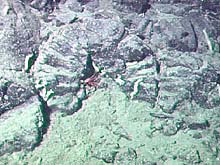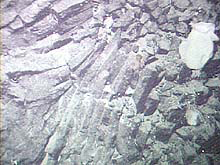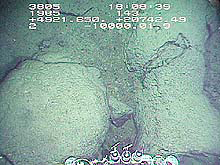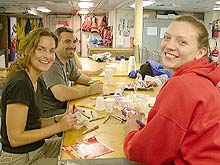
These distinct shapes on the seafloor are fractured pillow basalts typical of volcanic rocks on Chirikof seamount. Click image for larger view.
Revealing the Secrets of Ancient Volcanoes
July 11, 2002
Dr. Randall Keller
Oregon State University
![]() Watch a video of Alvin collecting volcanic rock samples. (mp4, 4 MB)
Watch a video of Alvin collecting volcanic rock samples. (mp4, 4 MB)
On existing charts, Chirikof seamount appeared to be a pair of elongate peaks stretching westward from the Gulf of Alaska toward the Aleutian Islands. However, our full-coverage SeaBeam mapping revealed that Chirikof is actually a series of smaller seamounts with depressions on top that look very much like individual volcanoes topped by craters. As we passed over Chirikof during our survey the night before our dive, the volcanic form of the seamounts became apparent. We were heartened to see that our dive target would be another volcano. The next morning, as the Alvin set down on the seafloor, we were disappointed to look out the porthole and see only flat terrain covered by sediment. But after a few minutes of driving Alvin uphill, we left the sedimented area behind and spent the next five hours climbing steep slopes of volcanic rocks exposed in amazing detail.

These basalt “columns” are several feet long and have the distinct six-sided shape of columnar jointing seen in some famous basalt flows on land. Click image for larger view.
Our geologic explorations of Chirikof and three other seamounts in the Gulf of Alaska have been like a field trip in volcanology. Volcanic features such as pillow basalts and columnar jointing stood out on the seafloor in spectacular detail. Pillow basalts are 1- to 3-feet-wide bulbous shapes of black volcanic rock unique to underwater lava flows. As water quickly cools the outer crust of a flow, the lava continues to move inside the crust, expanding and breaking the crust and surging out in new directions. The end result is a jumbled pile of pillow-like blobs. Columnar jointing is a fairly common feature in large lava flows on land, but we had not seen it on the seafloor before this expedition. It occurs when a lava flow cools slowly and the cracks that form as it cools organize into a hexagonal (six-sided) pattern. When viewed from the side, this pattern of cracks creates the striking six-sided columns of famous volcanic features such as Devils Tower in Wyoming and Devils Postpile in California.

This photo shows ancient lava tubes on the seafloor. Lava flowed downhill through these tubes. Click image for larger view.
We did not expect such impressive exposures of volcanic rocks to accumulate on seamounts that have been exposed to sediment raining down from the ocean above for over 25 million years. Apparently, strong ocean currents across these seamounts keep the sediment from accumulating. So the original volcanic rocks are still nicely exposed. In some places, we could clearly see the tubes and conduits where the lava flowed down the mountainside, making it easy for the geologists to picture these ancient volcanoes in their time of eruption. A field trip to the volcanically active areas of Hawaii or Iceland would not have been more revealing.
However, sampling the rocks was not always as much fun as looking at them. In some places, the rock was so solid on the mountainside that even Alvin's titanium fingers could not pry a sample loose. In other places, we would take a sample that was too large to fit in our sample basket. It often took skillful positioning by the pilot to hold Alvin in place against the strong ocean current for long enough to pry a rock out of the outcrop. In most cases, we were successful, and got the rock samples that we needed. However, we will not be able to establish the ages of these volcanoes and determine their chemical fingerprints to see how they are related to each other and to the Cobb hotspot until we get back to our laboratories in Oregon.

Catalina Martinez, Pete Risse, and Sara Flood Page (from left to right) coloring Styrofoam cups in the main lab on the Atlantis. Click image for larger view.
Under Pressure
Catalina Martinez
NOAA Office of Ocean Exploration
The deep sea is vast and extremely cold, it is dark beyond imagination, and organisms that live there must be adapted to these conditions as well as the tremendous pressure that exists at depth. High pressure is a serious consideration for those who visit the sea floor in submersibles, as pressure increases one atmosphere with every 10 meters. Consider visiting the deep sea at 4,000 meters. You would be entering a world that is 400 times the atmospheric pressure that you normally experience at sea level. This extreme environment is one in which humans can visit only within very special vehicles such as the Alvin. One atmosphere of pressure is maintained at all times within the titanium sphere inside Alvin, and this sub resists the compressive forces associated with the deep sea, up to about 4,500 meters.
Fun With Styrofoam!
Coloring Styrofoam cups is a major pastime on board the Atlantis, as they are gathered in net bags and tied to the Alvin to be compressed at depth. These ‘squashed' souvenirs of the deep are favorites with children and adults, alike!
Reaching out while on the Atlantis
OE expedition coordinator, Catalina Martinez, spent several years prior to her position with OE teaching students as well as teachers in her native state of Rhode Island about the marine environment. Although Rhode Island is called the ‘Ocean State,' many of the urban children have no exposure to their own coastal communities, and so grow up learning very little (if anything) about the ocean. Although Catalina recently moved out of Rhode Island, she has maintained a very special connection with the students and staff of an alternative middle school located in Providence, Rhode Island called UCAP (Urban Collaborative Accelerated Program) ![]() . This two-year, independent public school program is designed to work with students who have stayed back at least one year in school. UCAP is based on an accelerated curriculum, whereby students have the opportunity to make up for lost time by working through three grade levels in two years, or two grade levels in one year if they work very hard.
. This two-year, independent public school program is designed to work with students who have stayed back at least one year in school. UCAP is based on an accelerated curriculum, whereby students have the opportunity to make up for lost time by working through three grade levels in two years, or two grade levels in one year if they work very hard.
Students at UCAP decorated Styrofoam cups during a summer program, and shipped them to Kodiak, Alaska for Catalina to pick up during the one-day port stop. These cups were sent down on the Alvin and will be given back to the UCAP students when Catalina visits the school to present the research cruise findings in the fall. Lesson plans that were developed for the Gulf of Alaska cruise were also sent to UCAP science teachers for use during their summer biology course.
Sign up for the Ocean Explorer E-mail Update List.



























